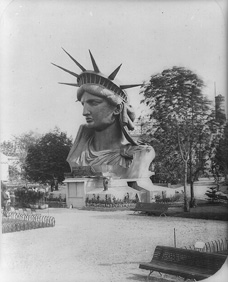A Gift of Friendship

Édouard de Laboulaye, a French law professor, wanted to honor America’s freedom and to remember the friendship between the United States and France, which dated back to the Revolutionary War (1775–1783). At a dinner party in 1865, Laboulaye shared his idea of a symbolic gift with Frédéric Auguste Bartholdi, a French sculptor. Bartholdi was enthusiastic about the concept, but several years passed before he was awarded the commission for the monument.
In 1874, Bartholdi visited the United States to look for a suitable location for a monument. He found it in Bedloe’s Island, now named Liberty Island, in New York Harbor. Upon seeing the spot, Bartholdi claimed that he also settled on what he would build. Naming it “Statue of Liberty Enlightening the World,” he vowed that it would be the largest statue in the world.
While the original hope was to present the structure to the American people in time for the centennial of the Declaration of Independence in 1876, that was not to be. The statue took about nine years to build. First, Bartholdi designed a small-scale model, from which he made magnified measurements. The enormous work then took shape in sections. Individual wooden molds were constructed. Around these were hammered the statue’s copper “skin.” These individual parts then were pieced together. The whole structure was supported by a secondary framework of iron and steel. Alexandre Gustave Eiffel, who would become famous as the engineer of France’s Eiffel Tower in 1889, designed the interior skeleton.
Bartholdi designed the statue holding a torch aloft in its right hand, symbolizing enlightenment and lighting the way to freedom. In its left hand is a tablet with the date “July 4, 1776” chiseled in Roman numerals. The seven spikes in the crown represent the seven continents and seas of the world. Around Liberty’s feet lie the broken shackles of tyranny.

When it was finished in July 1884, Liberty was put on display in Paris until it was time to prepare it for the journey to America. Because of its enormous size—it measured nearly 152 feet tall, with the head alone measuring more than 17 feet tall—Liberty was taken apart. The 350 pieces were numbered and packed into 214 large crates to be shipped across the Atlantic Ocean.
Upon arrival in New York Harbor on June 17, 1885, however, there was no place to put Liberty! Part of the agreement for accepting the gift was that Americans would provide the pedestal for it. Contributions toward this were slow until newspaper owner Joseph Pulitzer wrote editorials that criticized Americans for failing to participate. He also offered to print in his newspaper the name of anyone who contributed toward the pedestal. The foundation and pedestal, measuring more than 150 feet high, finally were completed in April 1886.
Putting Liberty back together was like assembling a giant jigsaw puzzle, but the job was finished during the summer of 1886. Drizzle and fog clouded New York Harbor on October 28, yet thousands of people came for the dedication activities. They watched the parades and fireworks, but the roar of the cannon, the blasts of the boat whistles, and the cheering of the crowds drowned out the speeches. When Bartholdi unveiled the copper statue, it was the color of a bright new penny.
Through the years, Liberty’s reddish-brown color changed to pale green due to the elements’ effect on copper. The statue also became damaged and dirty. In preparation for its 100th birthday celebration in 1986, the Statue of Liberty was closed for two years. Workers patched the holes in the skin and scrubbed it from the top of its crown to the tips of its four-foot toes with walnut hulls, corncobs, bicarbonate of soda, and liquid nitrogen. With a new torch in its hand today, the Statue of Liberty continues to light the way to freedom and remains both a symbol of welcome to travelers and international friendship.
Just a Taste
As America’s 100th birthday approached, Congress voted to hold a Centennial Exposition in Philadelphia in 1876. Although the Statue of Liberty was still under construction in France, the 42-foot right arm, which held the torch, was already finished. The French government decided to send it to the exposition to help raise money for the statue.
Workers dismantled its 21 sections and packed them into 21 wooden crates for the voyage across the Atlantic Ocean. When they arrived at the exposition in August 1876, the sections of the arm were rejoined. A ticket booth was constructed around the base.
Large crowds came to admire the arm. It became one of the most popular attractions at the exposition. Newspaper articles reported that about 125,000 people paid to climb the narrow ladder inside the arm to the outside balcony to view the fairground.
The arm was dismantled and returned to France in early 1884. It was fitted to the completed Statue of Liberty for presentation to the American ambassador in Paris before reshipment to America in 1885. So, Liberty’s arm crossed the Atlantic three times!